Day 1 of a 2 day Private Tour today. It was intended to be a relaxed couple of days of general Norfolk winter birding. We met up in Wells and headed east along the coast.
We had not gone far when we saw our first Barn Owl of the day. It was hunting over a patch of rough grass on the edge of a field by the road. We watched it for some time, flying slowly up and down, occasionally dropping down into the grass but then taking off again empty-taloned. Eventually it worked its way back up along the grassy field margin beyond and disappeared out of view. It had been a wet night last night, and Barn Owls will often hunt into the morning when they have struggled to feed the night before.
As we got to the edge of the reserve at Cley, we spotted our second Barn Owl of the day, hunting over the grazing marshes by the West Bank. It landed on one of the fence posts and stared intently at the grass below for a while. Then it took off again, wheeled round for a second and landed on the next post along, from where it had another look at the ground. It repeated this a couple of times before flying off towards the Beach Road. We followed it for a while, as it worked its way east along the fences. It was quite a pale bird, with rather white wings, so possibly a male.
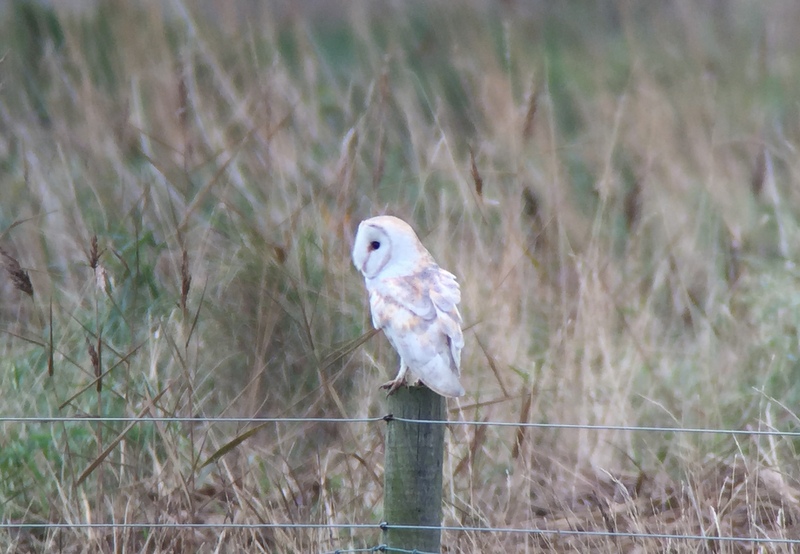 Barn Owl – our second of the day, a pale bird at Cley
Barn Owl – our second of the day, a pale bird at Cley
As it disappeared out across the reserve, we turned to look back towards the Mill and yet another Barn Owl appeared over the West Bank. This was a noticeably browner bird, presumably a female. It landed on one of the same fence posts that the male had been on earlier and proceeded to scan the ground below as he had done. Eventually, it saw us watching it and flew off back towards the Mill. Quite a way to start the day with not one, not two, but three Barn Owls.
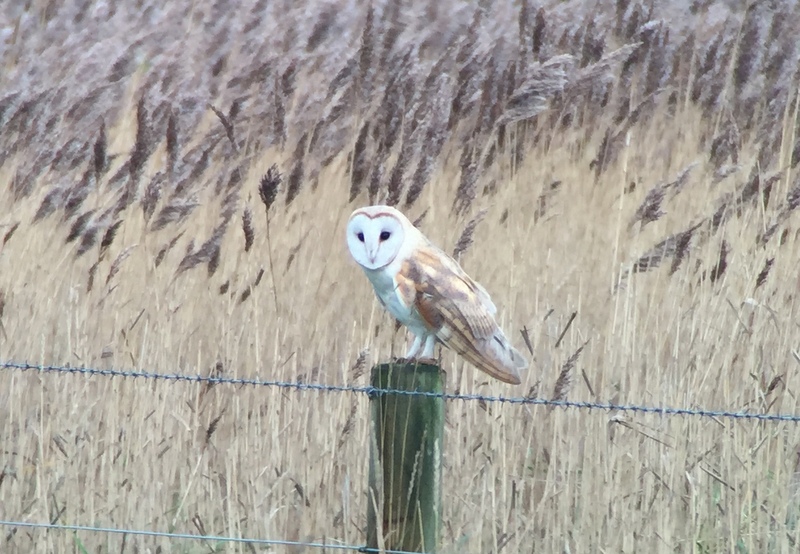 Barn Owl – and another one, a darker bird, also at Cley
Barn Owl – and another one, a darker bird, also at Cley
We tore ourselves away from the owls and had a quick look down along Beach Road, but there were no Brent Geese in the fields here today. So we drove back to the Visitor Centre to park and set out onto the reserve. A Common Buzzard was perched up on the hedge behind, and a large flock of Curlew and Lapwing came up off the reserve and flew inland to feed in the fields.
We headed across to Bishop Hide. A couple of Marsh Harriers were circling out over the reeds – a female, with pale creamy-yellow head and shoulders, and a smaller, darker male. They spent some time sitting around in the bushes in the reedbed and we got a good look at the female in the scope.
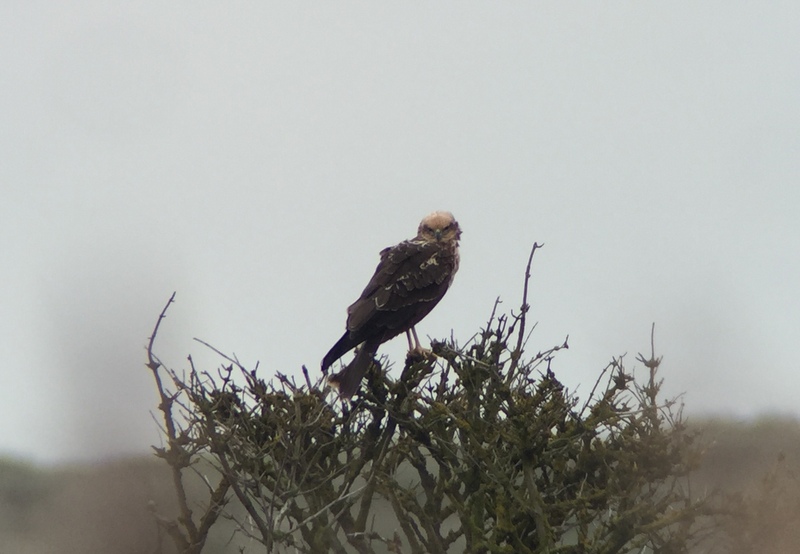 Marsh Harrier – one of two out over the reedbed this morning
Marsh Harrier – one of two out over the reedbed this morning
With the water levels high at the moment, there are not so many waders on the scrapes currently. However, there are quite a few Avocets around, with at least 17 on Pat’s Pool today. They were mostly asleep, but the odd one did wake up just long enough for us to get a good look at its distinctive upturned bill. There were also a number of Black-tailed Godwits out feeding at the back and a few Redshank and those Lapwing which hadn’t flown inland to feed.
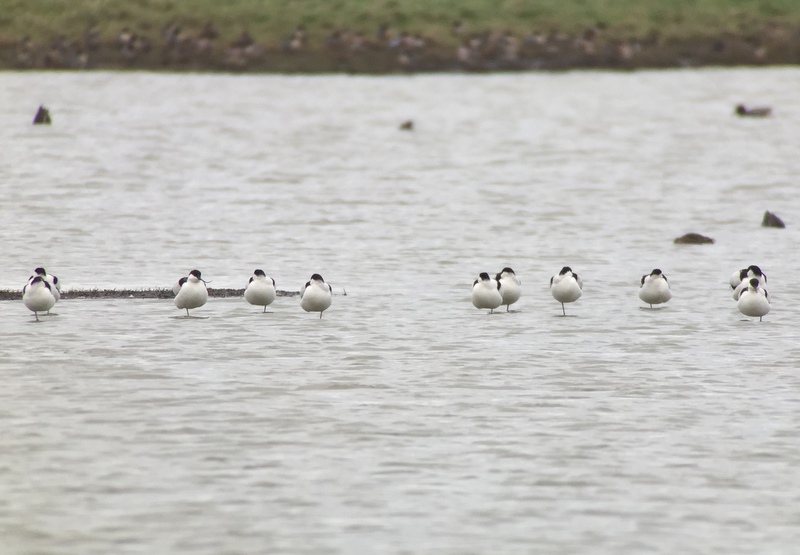 Avocet – part of the group which was roosting on Pat’s Pool today
Avocet – part of the group which was roosting on Pat’s Pool today
There was also a good selection of wildfowl to go through. We spent some time admiring the Shelduck, Wigeon, Teal, Gadwall and Shoveler, noting their distinguishing features. There were the usual Mallard as well and a large flock of noisy Greylag Geese dropped in.
We decided to set out along to the East Bank. In the brambles by the path, we could hear a Cetti’s Warbler calling. We had a glimpse of it, but it refused to show itself – not a great surprise as they are naturally very skulking birds. At the start of the East Bank, we stopped to admire a Little Egret which was feeding on the pools. It flew out from a channel in the reeds, flashing its yellow feet as it flew.
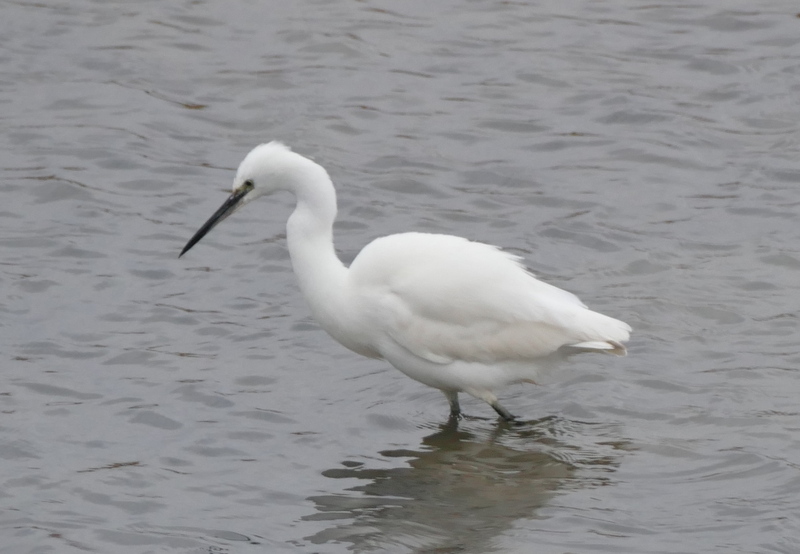 Little Egret – feeding by the East Bank this morning
Little Egret – feeding by the East Bank this morning
We walked out along the bank towards the sea, scanning the marshes as we went. The highlights were the Pintail. We watched a pair feeding, upending in the Serpentine, the male resplendent in breeding plumage, with its chocolate brown head and white stripe up its neck, and the very elegant female. A little further over, several more were asleep on the islands and a male standing out in the open allowed us a great look at the distinctive elongated tail feathers from which it gets its name. We also stopped to admire the Teal feeding on the grassy pools just below us – the males also looking very smart now.
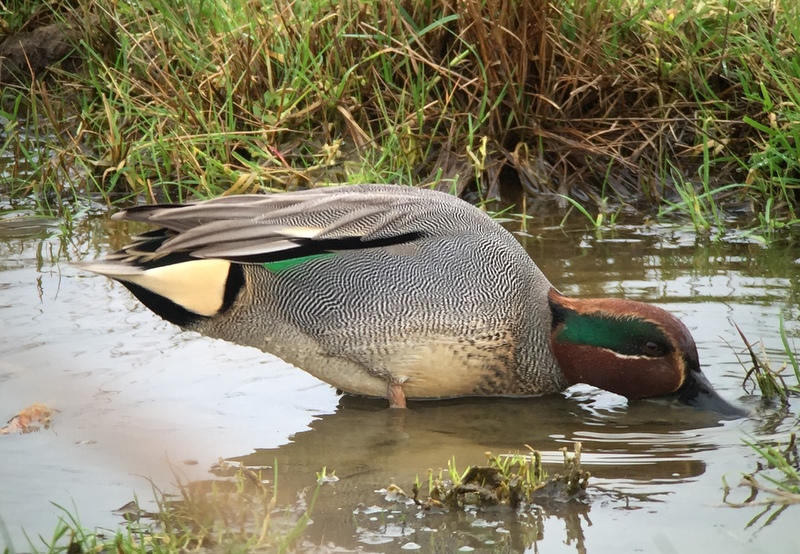 Teal – a smart drake feeding on the grassy pools by the East Bank
Teal – a smart drake feeding on the grassy pools by the East Bank
There were also lots of Dunlin running around the muddy pools out across the grass, our commonest small wader and noticeably small compared to the Lapwing next to them. A couple of Cormorants were drying their wings. In the main drainage channel, we stopped to look at a couple of Little Grebes diving. Out on Arnold’s Marsh, we picked out a lone Grey Plover and a couple of Oystercatchers.
Having come this far, we had to have a quick look at the sea. It was quite choppy and hard to get on the birds which were out on the water – a few Guillemots, a Great Crested Grebe and a Red-throated Diver – not helped by the fact that they were diving constantly. A Great Black-backed Gull was swimming a short way behind one of the Guillemots, eyeing it hungrily. A Gannet flew past further out. The cloud had thickened and it started to drizzle, so we beat a hasty retreat.
By the time we got back to the road, the rain had stopped again. We stopped to watch a pair of Stonechats on the edge of the reeds. The male flew over into one of the bushes by the path and started flycatching, swooping up into the air after insects before dropping back down onto the same perch. The weather has been so mild, there are still lots of insects around at the moment. Then we made our way back to the car.
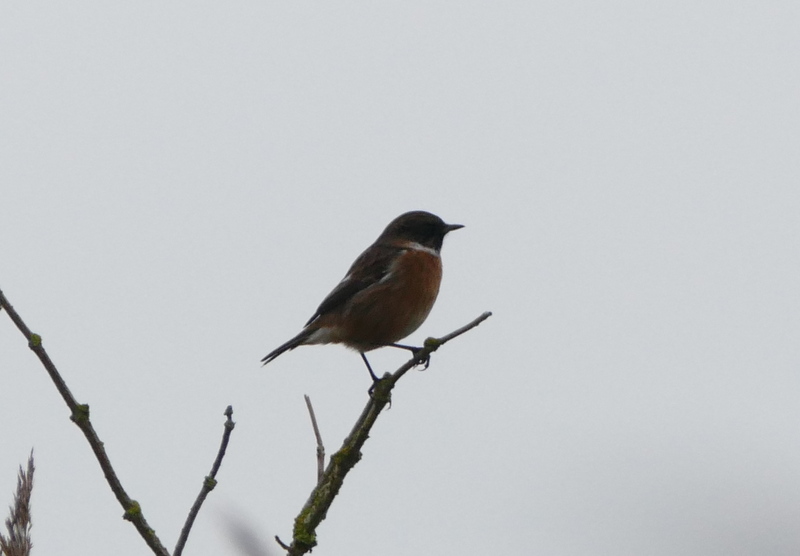 Stonechat – this male was flycatching by the path
Stonechat – this male was flycatching by the path
We still had a bit of time before lunch, so we drove a little further east along the coast. We hadn’t gone very far at all when we spotted a large flock of Brent Geese feeding in the winter wheat field behind Walsey Hills. We pulled in at the entrance to Pope’s Marsh to get a better look at them.
We could see a good number from where we were, but it was clear there were even more just over the brow of the hill. However, a scan through those we could see revealed one with strikingly pale flanks and belly, noticeably whiter than all the others. The vast majority of our wintering Brent Geese are Dark-bellied Brents from Russia. This was a Pale-bellied Brent, a different subspecies which breeds in Arctic Canada, Greenland and islands in the far north Atlantic such as Svalbard and Franz Josef Land. The odd Pale-bellied Brent gets lost and finds itself in with our Dark-bellied Brents.
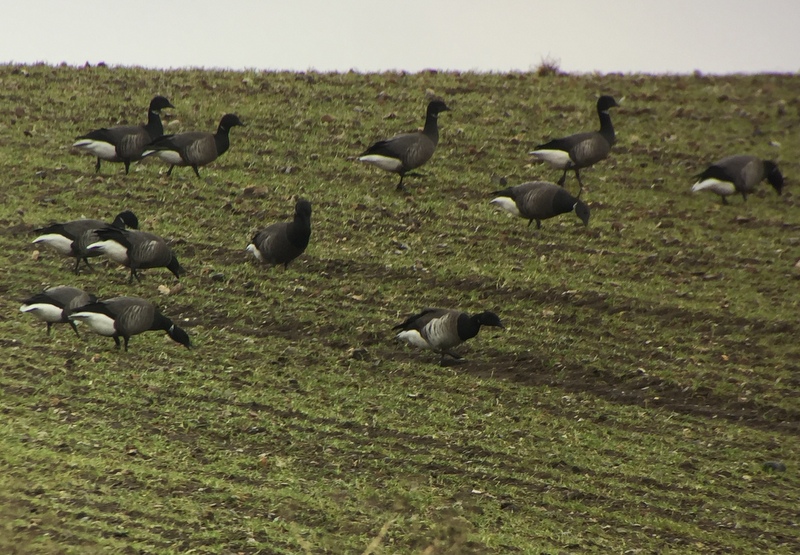 Pale-bellied Brent – just one in with a flock of Dark-bellied Brent Geese
Pale-bellied Brent – just one in with a flock of Dark-bellied Brent Geese
While we were watching the Brents, a large flock of Linnets was whirling around behind us. The field across the road from us was recently harvested sugar beet, and the Linnets were feeding out there, presumably finding weed seeds. We turned to look at them and the longer we stared at the field, the more birds we found.
A Pied Wagtail flew across the field towards us and landed just opposite. The next thing we knew, it was joined by several more Pied Wagtails. Then several pipits flew across as well and when we turned the scope on them we realised that not only were there several Meadow Pipits, but a Water Pipit was in amongst them. The birds were moving constantly, walking quickly across the field feeding or flying in short hops. It rapidly became clear that there were several Water Pipits there, at least 3-4 and possibly more – it was very hard to count them properly.
There had been several Water Pipits on the other side of the reserve, around the new pools on Pope’s Marsh, a few weeks ago. They are obviously now finding better feeding opportunities in the fields opposite!
We then drove further along the road, towards Kelling, where we knew a flock of geese were feeding in another recently harvested sugar beet field. Unfortunately, there were several people looking at them and no spaces left to pull off the bust road. It also started to drizzle again, so we drove back to the Visitor Centre at Cley for lunch. After lunch, we decided to have another go and thankfully this time we managed to find a space to park in.
There were a few Brent Geese feeding in the winter wheat here too, but our main interest was in the large flock of Pink-footed Geese feeding on the beet tops left behind after the harvest. There were at least a thousand here, either out feeding or loafing around in the wheat fields nearby. The Pink-footed Geese come here from Iceland for the winter, but a large gathering of geese frequently attracts others too.
A scan through the flock immediately revealed a few White-fronted Geese. We have a few smaller flocks of these which winter in Norfolk but they very occasionally get in with the Pinkfeet. The adults immediately stand out, with the distinctive white surround to their bills.
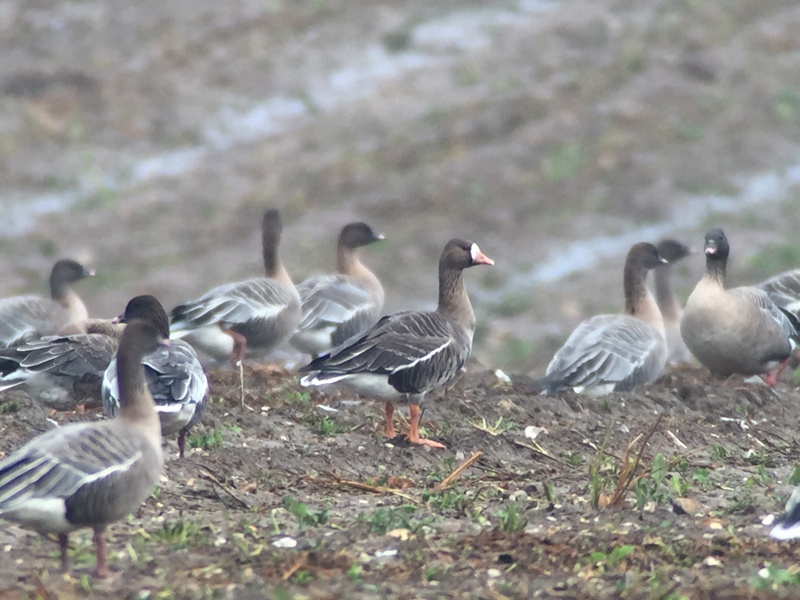 White-fronted Goose – feeding in with the Pinkfeet
White-fronted Goose – feeding in with the Pinkfeet
The Tundra Bean Geese are harder to pick out, rather similar to a Pink-footed Goose but with orange legs and a similarly orange band round the bill, rather than pink. Thankfully, some other birders were already watching two Tundra Bean Geese lurking in the flock and they were able to get us straight onto them. Tundra Bean Geese mainly winter on the continent, in Netherlands and northern Germany, but a small number often drift across the North Sea and get mixed in with our vast flocks of Pink-footed Geese – the challenge is picking them out!
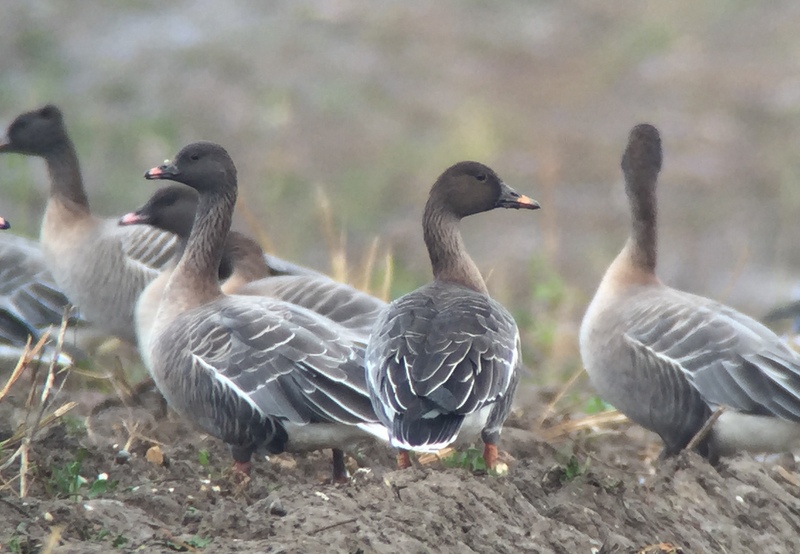 Tundra Bean Goose – the orange legs and bill band differ from Pinkfeet
Tundra Bean Goose – the orange legs and bill band differ from Pinkfeet
It was fortunate that we were put onto the Bean Geese so quickly as we hadn’t been watching them for long when all the geese started looking nervous. Their necks went up and they started looking round. Then the whole flock started walking quickly out into the middle of the field, away from the hedge. Then they all took off and flew down onto the grazing marshes down towards Salthouse.
They flew round again once or twice but seemed reluctant to settle again – we couldn’t see what had disturbed them. Still, it was great to see a large flock of Pinkfeet circling overhead and listen to their high-pitched yelping calls, one of the real sounds of Norfolk in the winter.
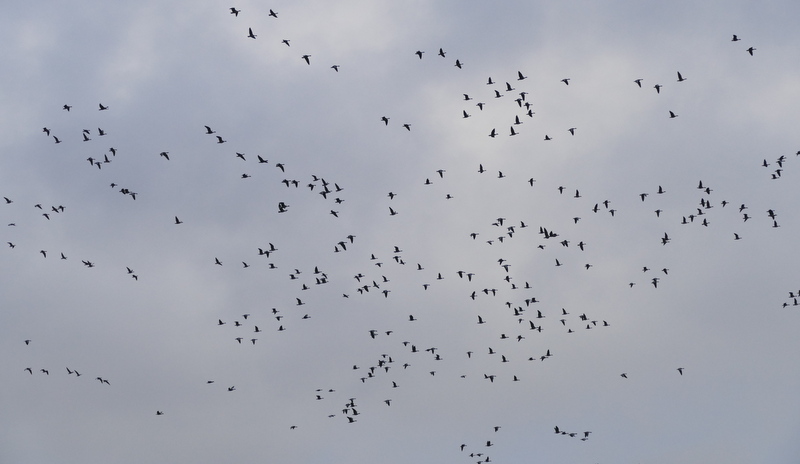 Pink-footed Geese – a real sight and sound of Nofolk in the winter
Pink-footed Geese – a real sight and sound of Nofolk in the winter
We wanted to make one last stop at Warham Greens this afternoon, so made our way back west. As we walked down along the track, there were lots of birds in the hedges by the weedy cover strips in the fields, mixed flocks of finches and buntings. The highlight was the Yellowhammers, the bright canary-yellow headed males and duller greeny-yellow females. We got several in the scope so we could get a good look at them. There were also a few Reed Buntings, several Chaffinches and Greenfinches, and a large group of Linnets.
It wasn’t long after we got to the edge of the saltmarsh that the first Hen Harrier appeared, a ringtail – the generic term for females and the similar-looking juveniles (of either sex). We watched it fly in over the saltmarsh and drop down over towards the beach, flashing the white square on its back at the base of its tail as it flew.
We saw a couple more ringtails arrive, but the male Hen Harrier really stood out. Pale ghostly grey with black wingtips, he flew straight towards us from the direction of Wells and then proceeded to fly back and forth for a few minutes in front of us, eventually working his way back out towards the beach. He also flushed a Merlin from the saltmarsh as he approached, which zoomed backwards and forwards past him before dropping down to the ground again.
Unfortunately, the weather deteriorated again while we were there and although we only suffered a very brief bout of drizzle it meant that the light faded fast. We did manage to add a late Peregrine which flew in from the direction of the beach and off inland. Then we headed for home too.
















